The beginningThe name Leenhouts can be positively followed back to about 1588, the year that Jan Lenout and his brother Pieter Lenout (some earlier or later) were born in the surroundings of Leuven, Belgium nowadays. During that time, the state Belgium did not exist, this area was part of the 'Southern Netherlands'. It was during the so-called '80 Years War' against the Spanish. The Spanish were catholic and in the Netherlands, but also in large parts of France, there were a lot of reformed christian people. Spain did not appreciate that and tried to bring the people from the 'lowlands' back to the 'right way'. This was one of the most important arguments for this war.
The earliest Leenhouts people we know today were reformed, so there were probably good reasons to refuge. In particular to Zeeuws Vlaanderen (the area in the nowadays southern part of the Netherlands, part of the province Zeeland) where 'Prins (prince) Maurits' was establishing a defense network and was fighting against the army of Phillips II, the Spanish king. Prins Maurits, also a reformed man, was an ancestor of the later 'Orange-Nassau-Dillenburg' family, the Dutch Royal family. So they probably felt safe in this area.
All research in Leuven and surroundings was unsuccessful. Questions arise: did they change their surname (for safety reasons) and how long did they stay in the surroundings of Leuven. In other words, did the family originally came from a different place in the Southern Netherlands, or were they refugees of one of the eight 'Huguenots wars' in France? One has to know that during that time hardly nothing was written down. Normally just baptizes, marriages and burials were registered by the churches. Only in larger towns or cities more information was written down. Supposed that the family stayed very shortly in this area or if nothing happened during their stay, there were no writings.
There are a lot more questions concerning these early days. Why is there no other branch of Leenhouts or Lenout, as it was spelled? Now I assume that Jan and Pieter had parents called xx Lenout (father) and an unknown mother.but did they also came to the Netherlands? Were they alone or with their wifes and children. When did he come, in which year?
There are indications that Jan Lenout came initially to Cadzand. The birthplace of his first two or three children is unknown at this moment but it can be Cadzand. Willem Lenout (1630-1680) is the first of the children, where Cadzand is positively the place of birth. The next child, Cathalijntje (1632-), is born in IJzendijke. So he moved with his family, from Cadzand to IJzendijke, between 1630 and 1632. Another story tells us, that Jan served in the army in Retranchement (Cadzandria), later also in IJzendijke.
An interesting point is that Pieter Lenous, soldier, got a daughter Marijtje (1632- ), also in Cadzand. The mother was not mentioned in the writing. Did Pieter and Jan both served in the army? There is no later information of Pieter and his daughter. Did this branche end here? There are a lot of questions left but:
One thing is for sure: all people in the world, whether it is in the Netherlands or in America, with the name 'Leenhouts', are descendants of Jan Lenout from Leuven.
Zeeuws Vlaanderen
From the beginning that the Leenhouts were settled in Zeeland, the Netherlands (the early 1600's), the whole family lived for more than hundred and fifty years in a very small area of the western part of Zeeuws Vlaanderen. Before about 1590, the area was occupied by Parma, a Spanish Duke in the army of Phillips II of Spain. In the period 1590-1620 Prins Maurits was fighting here with varying success. In 1591 Hulst was occupied by his army, in 1604 IJzendijke, a fortress built by the Spanish in 1587. After the occupation of the whole area it became more or less quiet.
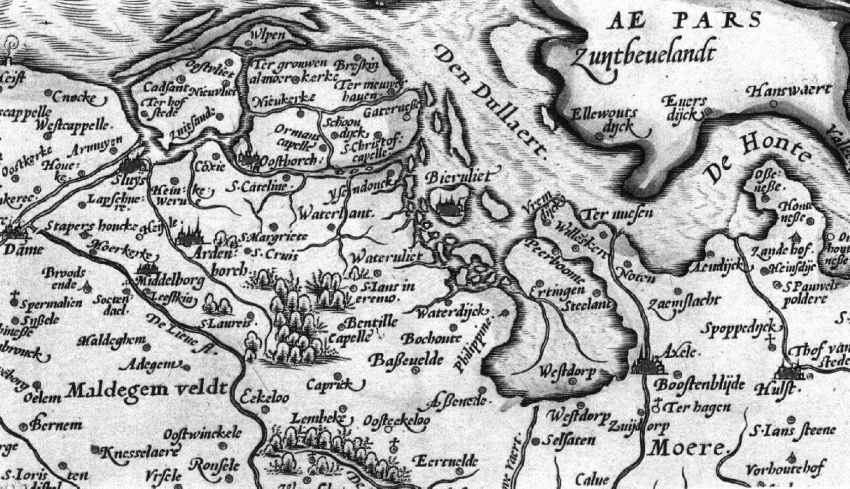
map of western Zeeuws Vlaanderen 1570
click on the map to view this picture on a comfortable size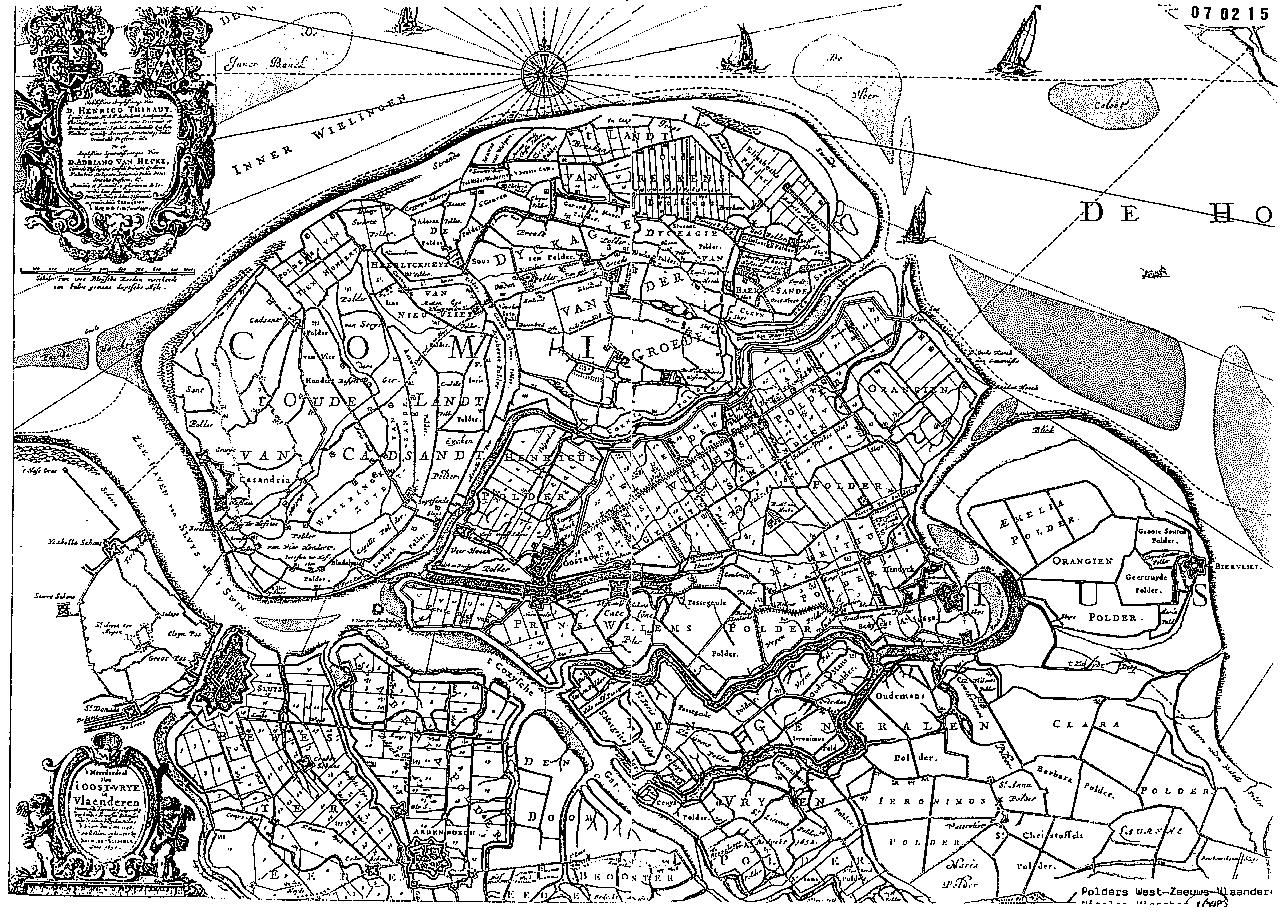 map of western Zeeuws Vlaanderen 1640
map of western Zeeuws Vlaanderen 1640
click on the map to view this picture on a comfortable sizeThis resulted in the growth of villages. People started to build churches and farmhouses. It's an area in the estuaries of the river Scheldt with many small islands and creeks. By building dykes, the sea was prevented to fluid the country. Canals and sluices were needed for drainage and shipping. The shape of the land changed slowly (compare both maps from 1570 and 1640). Also the Leenhouts people living here were involved in this work. We read in the overview of activities 1651/54 of the 'Generale Prins Willempolder' ('polder' is drained lowland, surrounded by dykes), that Jan Leenhouts junior (1620-1675) calculated to build a dyke. Later he did the same for the construction of a canal (for shipping). The same made a canal alongside a path for drainage. Willem Lenout (1630-1680) constructed a canal for drainage. Jacob worked on a canal near the sluice of Sasput. Jan Lenout sr (1588-1669), called the 'Brabander' (Leuven, where he came from, is situated in the province Brabant), worked on the construction and maintenance of the 'Keedijk' (dyke). So, one can assume that after a period of fighting against the Spanish, a new period started to fight against the sea. However the water was not just an enemy. It was also a friend, to be used for shipping. Claes Lenout (1623-1674) was a skipper, and his son Crijn (1652-1694).
In a book on small ferries, seven hundred years transport over water, (jhr. mr. G.F. Sandberg, Arnhem, 1978) we can read that on 22 October 1678 a certain Jan Maartens got permission to sail the ferry from Turkeije near 'den Oudenman'. Pieter Leenhouts (1652-1704) however, received some time earlier a written permission from His Excellence Mr van de Lek, governor of Sluis, to do this job. Just on 17 June 1683, some years later, after the death of the governor, it was decided to share the job of ferryman.Building dykes resulted in new land and new opportunities for farming. It was near IJzendijke that the first Leenhouts settled as farmers. This continued for more than three hundred years. Not only in IJzendijke but also in places like Biervliet, Cadzand, Schoondijke, Groede, and some other small places, all in this area. This were small communities with a high social control where the church played an important role. The religion was one of the reasons for emigration from this area to the United States in the period from 1848-1912 (see later). Also many Leenhouts went to the States but the most remaining people continued with their farm and cattle. It was after World War II that, like on other places, the Leenhouts moved all over the country.
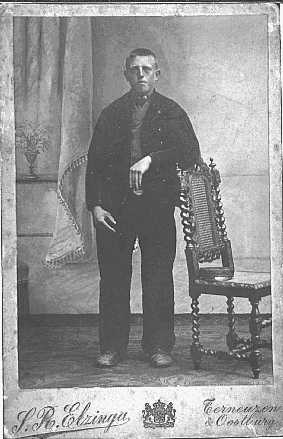
Jozias Abraham Leenhouts (1887 - 1981)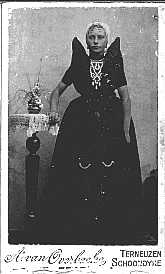
Elisabeth Leenhouts (1891 - )Pictures taken in the early 1900's with the local dress of Zeeuws Vlaanderen, Zeeland, the Netherlands.
Emigration
Until 1840 the emigration from Europe to the United States was very limited. After that year the so called 'second emigration' started. This period, up to the first world war, can be called as the largest migration of the nations in history. Most Europeans arrived in New York on Ellis Island.
Most important reasons for the Dutch people to emigrate was the agrarian crisis (harvest failure of potatoes 1845 and grain 1846) and the separation of the Protestants from the 'Nederduits Gereformeerde Kerk', the Reformed church. The separatists felt hindered in the practice of their religion. They tried to find freedom of religion in the States.
The high prices of food and the surplus of manpower effected very low wages. Together with high taxes, many decided to move to the 'New World', stimulated by churches.The story of Pieter Leenhouts (1780) is reproduced here.
Letter written by Pieter Leenhouts to the various members of his family. It was written soon after his arrival in Wisconsin. The translation was made by Jacob A. Daim, an attorney in Kalamazoo, Michigan, at the request of Miss Josephine Leenhouts.
Milwaukee, September 25, 1848
Dear family:It has pleased the Lord to provide for us a place to live here in America. We are planning to leave for Michigan on the 7th, and we thought it best to take a few days rest. It pleased the Lord to arrange it so that when we left the boat we met some country folk with whom we became acquainted, and who provided a house for us, however without windows and doors. In this house we were permitted to live, eighteen of us, for $3 per week, and we have been there since then.
During this time we had the opportunity to inquire about transportation, because we were always planning to go to Michigan. We have become acquainted with J. de Vos, who formerly lived at Breskens, and who has a son who speaks good English, and of which fact we have made good use. He advised us to look around for wood land of which we might make use. However, we have changed our mind about that on account of the difficult and impassable roads and we have definitely determined to go to Michigan.
Not long ago we received a visit of a countryman named Jacob Verdouw, who helped in America at harvest time. He told us that his boss was planning to sell his farm, consisting of 200 acres, of which 80 acres is wood land and 120 acres prairie and pasture, of which latter 40 acres are tillable and suitable for wheat, oats, corn, white beans and potatoes; the potatoes however have been spoiled by smut, and so I have, as carefully as possible, investigated this land for the reason that it seemed to me that providing the price is right we should not overlook the opportunity because our complete household would be able to make a very comfortable existence with the Lord's blessing. The price would average $14 per acre, and that would include all his stock and tools, except his horses and wagon.
I have bought a lot in Milwaukee on Holland Hill for Izak Mersseman consisting of 54 rods and a dwelling in which Levina Leenhouts is living. This is close by and she is planning to build a house separate for herself.
I could write you a good deal about the big journey we have made, but I will put it off to some time in the future, hoping that it may please the Lord to continue us in life and in health, because we all have suffered much. Kornelis has been very sick, and Jannis, who still is in Michigan, has been deathly sick, of which fact we have received news on August 27th by Mr. Houtkamp who told us he was in serious condition. However, the doctors have observed some change in his illness so that there may be some hope for his recovery. Thereupon Susanna on September 3rd has left with Houtkamp and she promised that in the event he did not show signs of improvement to send us a message by express, and in the event we received no news we could hope for an improvement in his condition. Accordingly we have some guarantee of improvement because we have received no message. My wife also is weak, and all of us are now and then suffering from colds and fevers, and everyone has to be very careful of himself on account of the change of air, food and drink. I also want to let you know that Abram came with Houtkamp and that Pieter remained with Jannis. I think I have given you a very short insight in the condition in which we are now living. We are very anxious to get some news from our dear relations and all good friends, and to learn how everything is going in our dear fatherland, because here in America we are receiving very unfavorable news that all commerce in America is idle except the immigrants who arrive shipload after shipload, so that many of them are unable to obtain work and are at a loss to know how to get through the winter. We are very anxious to receive news of our nearest relatives and of all our good friends, in regard to their physical and spiritual well-being, and whether or not some of them may not have exchanged the temporary for an eternal condition. It would indeed be very pleasing to us if the Lord would permit us to see each other face to face where we are, because the country around here is very good, and in this vicinity there is much land to be had which is just as good as that which I have. There is even a small house for sale here with one acre of ground; a good house for the sum of $500, which is the equivalent of 1350 guilders in Dutch money, and this is located but one-quarter hour's journey from our house. We also hear that around about here there is quite a lot of work to be had, and a hired man could find work and make a living because he earns quite a little in odds and ends and with horses. It costs only $1 to shoe a horse all around. If necessary you could keep two cows because my pasture is only 15 minutes away. However, I do not insist that you shall come, but I would like to have you think it over. I would also like to know how the harvest has come out and what the price was of the crops and also this and that about the Estate of Luisleeren, whatever you may know about that.
I must stop now. We send our greeting to you and yours, and remain in expectation to receive a letter from you dear ones. May the Lord give us health, peace, faith and charity through the Holy spirit for the sake of His great Name. We have the honor to remain respectfully your servants.
-Pieter Leenhouts and Janna Haartsen
Destination of Leenhouts emigrants
The Leenhouts emigrants settled in several states in the United States. As far as I could trace, the following states and areas were the destination of the emigrants in the period 1848 - 1912. Later, some emigrants settled in other places in the United States and Canada.
Michigan between Grand Rapids and Kalamazoo Wisconsin north from and including Milwaukee New York Rochester and Wayne County Iowa north-west Minnesota unknown till now all Leenhouts where the destination is unknown
Michigan
.

Land Patent Description of William Leenhouts (1831 - 1906)
source Bureau of Land Management, Eastern States, General Land Office, USA
click on the picture to enlarge itIn particular the separatists had a strong motivation to emigrate. Their meetings were not longer allowed. When they meet illegally, there was the chance of very high penalties. This resulted in a mass emigration of church leaders and the separatists. Many of them arrived in Michigan and settled in places like Holland and Zeeland, roughly in the area between Grand Rapids and Kalamazoo. Sometimes the places were founded by the early emigrants. Some of them purchased land to start a farm. See the land patent description of William Leenhouts, who got 80 acres in Ottawa County, MI in 1857. The land patent description give the precise location of the land.
At least the following families and relatives settled in Michigan:
- 1847: Johannes Jonkheer (1809) and his wife Dina Levina Leenhouts (1808) and children
- 1848: Suzanne Leenhouts (1820); Jannes Leenhouts (1827) both children of Pieter Leenhouts (1780) and Johanna Haartsen (1786) who stayed in Wisconsin
- 1848: Jannis Leenhouts (1818) and his wife Catharina (1828)
- 1849: Abraham Leenhouts (1812) and his wife Francina van Kerkvoort (1811) and children:
Jannis (1834); Janna (1836); Elizabeth (1838); Izaak (1839); Cornelis (1844)- 1857: Willem Leenhouts (1837)

Wisconsin
The area around Milwaukee had a lot to offer. Good quality of land, large woods and Lake Michigan were very attractive for settlement of immigrants. Growing cities as Milwaukee formed a potential market for agricultural products and wood. Publications tried to lure Europeans to the state, Pieter Leenhouts and his wife and children settled here (see letter above).At least the following families and relatives settled in Wisconsin:
- 1848: Pieter Leenhouts (1780) and his wife Johanna Haartsen (1786) and children:
Cornelis (1815); Pieter (1816); Abraham (1819); Jakobus (1821); Magdalena (1825); Willem (1831), together with his married children:Later the following children of the same family arrived:
- Isaak de Mersseman (1786) and his wife Janneke Leenhouts (1806)
- Levina Leenhouts (1807), widow of Jozias Lucier (1788), and her children
- 1849: Johannes Kotvis (1812) and his wife Maria Leenhouts (1810) and children
- 1849: Izaak Kommers (1812) and his wife Elizabeth Leenhouts (1813) and children
- 1849: Elisabeth van Putten (1806), widow of Isaac Leenhouts (1809) and her son Isaac Leenhouts (1834)
- 1848: Pieter Leenhouts (1805) and his wife Maria van Putten (1803) and children:
Amelie (1830); Willem Jacob (1833); Avika Bastina (1838); Pieter (1839); Abraham (1841); Maria (1843)?. It is assumed that this family settled in Wisconsin.- 1891: Pieter Leenhouts (1833) and his wife Catharina Cornelia Ekkebus (1837) and children:
Pieter (1874); Magdalena (1876); Suzanna Maatje (1877); Izaak (1878)- 1892: Hendrik Anthonie Leenhouts (1892)

New York
Early 1840 already Dutch families settled in this area. They activated separatists to come to Wayne County. They settled eastern of Rochester to establish farms and agriculture (fruit).At least the following families and relatives settled in the State New York:
- 1869: Jacob Leenhouts (1846); (his brother Abraham (1850) in the same year to Iowa)
- 1885: Abraham Taillie (1842) and his wife Elizabeth Leenhouts (1841) and children
- 1891: Maria Suzanna Zonnevijlle (1835), widow of Willem Cornelis Leenhouts (1829) and children:
- Levina Maria (1867); Willem Jannis (1877). The family followed Jacomina Levina Leenhouts (1863), also a daughter, emigrated in 1890.
- 1889: Izaak Leenhouts (1859) and his wife Elisabeth Brakman (1855) and children:
Jannis Cornelis (1880); Pieter Izaak (1882); Izaak Pieter (1884)- 1889: Janna Leenhouts (1853), sister of Izaak Leenhouts (1859) (New York is uncertain)
- 1894: Pieter Anthony Leenhouts (1894), brother of Hendrik Anthonie (1892)
- 1895: Pieter Willem Leenhouts (1873)
- 1905: Pieter Abraham Leenhouts (1876) and his wife Anna de Reu (1877) and children:
Pieter (1900); Joseph (1901); Abraham Jan (1902); Janneke Catharina (1904)- 1906: Abraham Faas (1883) and his wife Jacomina Catharina Leenhouts (1884) and children
- 1909: Jannis Hubrecht Leenhouts (1887)
- 1912: Isaac Abraham Leenhouts (1884) and his wife Elizabeth Faas (1885) and children:
Henry (1906)?; Pieter (1907); Elizabeth (1908); Jannis (1911)
Pieter Abraham Leenhouts (1876) and Anna de Reu (1877) with their children.
It is assumed that the photograph was taken in the Netherlands, just before the emigration in 1905.source Gary Leenhouts

Iowa
The colonisation of the north-west area of Iowa started around 1870. The construction of the Chicago, Milwaukee and St. Paul Railroad stimulated the settlement of colonists between 1884 and 1890. The railroad company established a village in 1879, named Rock Valley. The developments in the States seemed to be very interesting in the Netherlands to the people who stayed there. They even invested in the developments, looking to the participation.At least the following families and relatives settled in Iowa:
- 1869: Abraham Leenhouts (1850) and his wife Johanna Cambier (1851)?. His brother Jacob (1846) emigrated in the same year to New York.

Minnesota
Good new agricultural land for a reasonable price stimulated many colonists to move to the mid-west. Already in 1858 an Isaac Leenhouts get almost 152 acres of land in Rice County, later in 1882 a Peter Leenhouts get 120 acres in Nobles County.

Land Patent Description 1858 of Isaac Leenhouts
(There are 2 Isaac Leenhouts (born 1839 and 1834)
emigrated to the USA. The one of this document is
uncertain at this moment)
source Bureau of Land Management,
Eastern States, General Land Office, USAclick on the picture to enlarge it
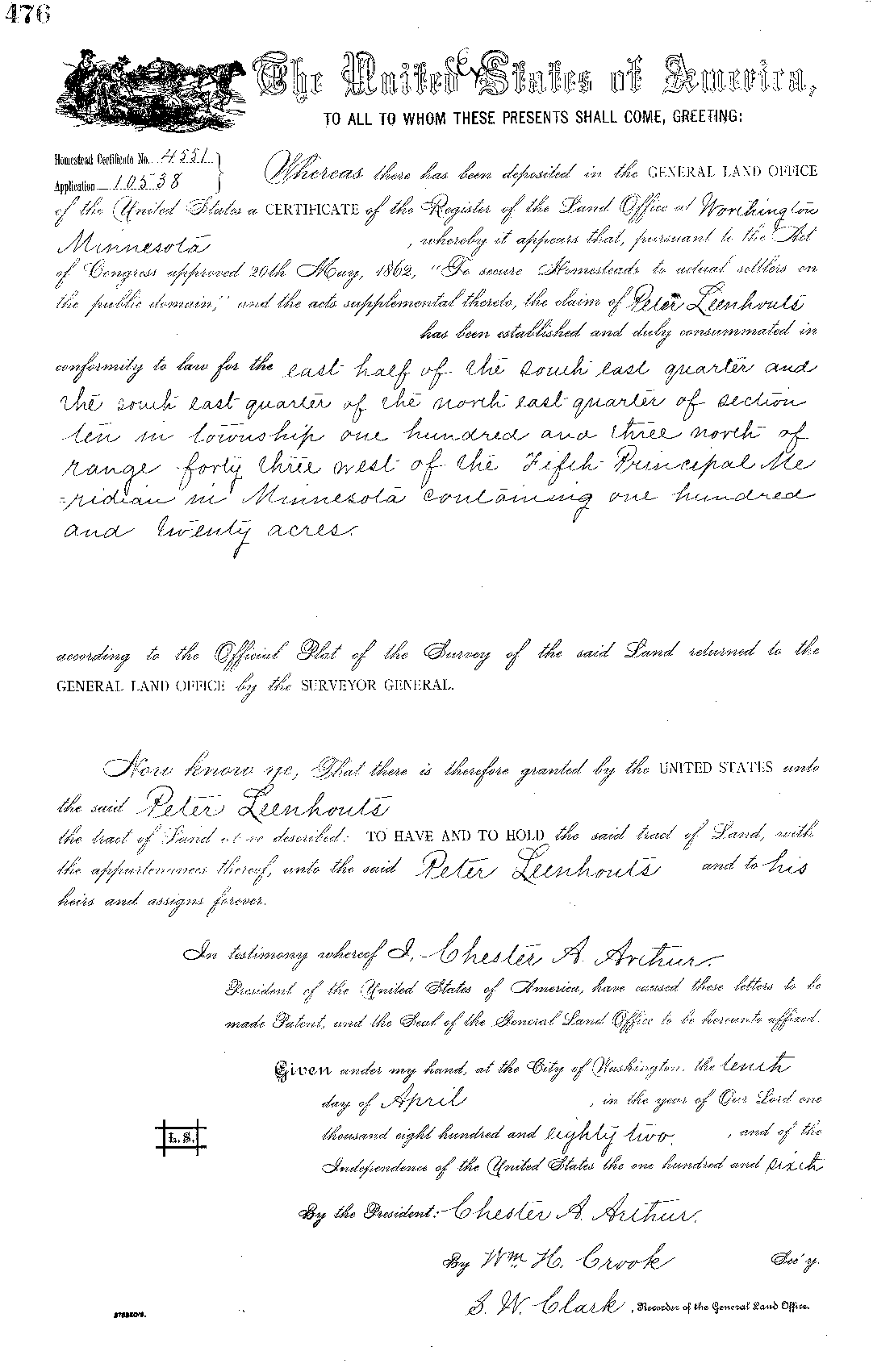
Land Patent Description 1882 of Peter Leenhouts
(There are 3 Peter or Pieter Leenhouts (born 1833, 1839
and 1854) emigrated or born in the USA. The one of this
document is uncertain at this moment)
source Bureau of Land Management,
Eastern States, General Land Office, USAclick on the picture to enlarge it
There are no families or individuals known, emigrated directly to Minnesota.
Unknown till now
Finally there are families and relatives settled in the United States where the state or place of settlement is unknown till now. It concerns:
And there were some emigrants which returned back to the Netherlands (for marriage or disappointed).
- 1848: Lena Leenhouts (1816) and Maria Leenhouts (1821), sisters
- 1848: Levina Leenhouts (1847)
- 1848: Magdalena Levina Leenhouts (1811)
- 1869: Elizabeth Leenhouts (1807), widow of Hybrecht van Peenen (1784), and her children
- 1872: Abraham Leenhouts (1837) and his wife Anna Jacomina le Cocq (1833) and children:
Adriana (1861)?; Isack (1864); Francis (1865); Maria (1869); Abraham (1872)- 1884: Abraham Leenhouts (1844) and his wife Maatje Tijdgat (1845) and children:
Jacobus Marinus (1871); Marinus Jacobus (1875) settled in Illinois?- 1892: Izaak Abraham (1859) and his wife Maria Suzanna Nortier (1856) and children:
Maria Suzanna (1885); Suzanna (1886); Jacomina Magdalena (1887); Magdalena Cornelia (1891)- 1893: Johannes Leenhouts (1881)
- 1906: Pieter Leenhouts (1885)
- unknown: Abraham Leenhouts (1877) and Marinus Jacobus Leenhouts (1879)
- 1872: Jannis Leenhouts (1842)
- 1895: Abraham Marinus Leenhouts (1871)
- 1904: Anthony Pieter Leenhouts (1867) and his wife Johanna Tromp (1865) and children:
Willem Cornelis (1891); Cornelis Willem (1894); Adriana Maria (1895); Anthony Pieter (1897)
© 2004 Wim van der Heijden